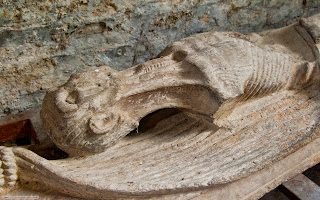.jpg)
A cadaver tomb or transi (or "memento mori tomb", Latin for "reminder of death") is a type of gisant (recumbent effigy tomb) featuring an effigy in the macabre form of a decomposing corpse. The topos was particularly characteristic of the later Middle Ages. A depiction of a rotting cadaver in art (as opposed to a skeleton) is called a transi. However, the term 'cadaver tomb' can really be applied to other varieties of monuments, e.g. with skeletons or with the deceased completely wrapped in a shroud. In the "double-decker" tombs, in Erwin Panofsky's phrase, a carved stone bier displays on the top level the recumbent effigy or gisant of a person as they were before death or soon after their death, where they may be life-sized and sometimes represented kneeling in prayer, and as a rotting cadaver on the bottom level, often shrouded and sometimes complete with worms and other flesh-eating wildlife. The iconography is regionally distinct: the depiction of vermin on these cadavers is more commonly found on the continent, and especially in the German regions. The dissemination of cadaver imagery in the late-medieval Danse Macabre may also have influenced the iconography of cadaver monuments.

.jpg)


Cadaver tombs were a departure, in monumental architecture, from the usual practice of showing an effigy of the person as they were in life. An early example is the famous effigy on the multi-layered wall-tomb of Cardinal Jean de La Grange (died 1402) in Avignon.
The term can also be used for a monument that shows only the cadaver without the live person. The sculpture is intended as a didactic example of how transient earthly glory is, since it depicts what we all finally become. Kathleen Cohen's study of five French ecclesiastics who commissioned transi tombs determined that common to all of them was a successful worldliness that seemed almost to demand them shocking display of transient mortality. A classic example is the "Transi de René de Chalons" by Ligier Richier, in the church of Saint Etienne in Bar-le-Duc, France.
These cadaver tombs, with their demanding sculptural program, were made only for high-ranking nobles, usually royalty or bishops or abbots, because one had to be rich to afford to have one made, and powerful enough to be allotted space for one in a church. Some tombs for royalty were double tombs, for both a king and queen. The French kings Louis XII, Francis I and Henry II were doubly portrayed, in effigy and as naked cadavers, in their double double-decker tombs in the Basilica of Saint-Denis outside Paris. Yet there are also other varieties, such as cadaver imagery on incised slabs and monumental brasses (including the so-called 'shroud brasses'), of which many can still be found in England.








.jpg)

.jpg)























.jpg)




Δεν υπάρχουν σχόλια:
Δημοσίευση σχολίου